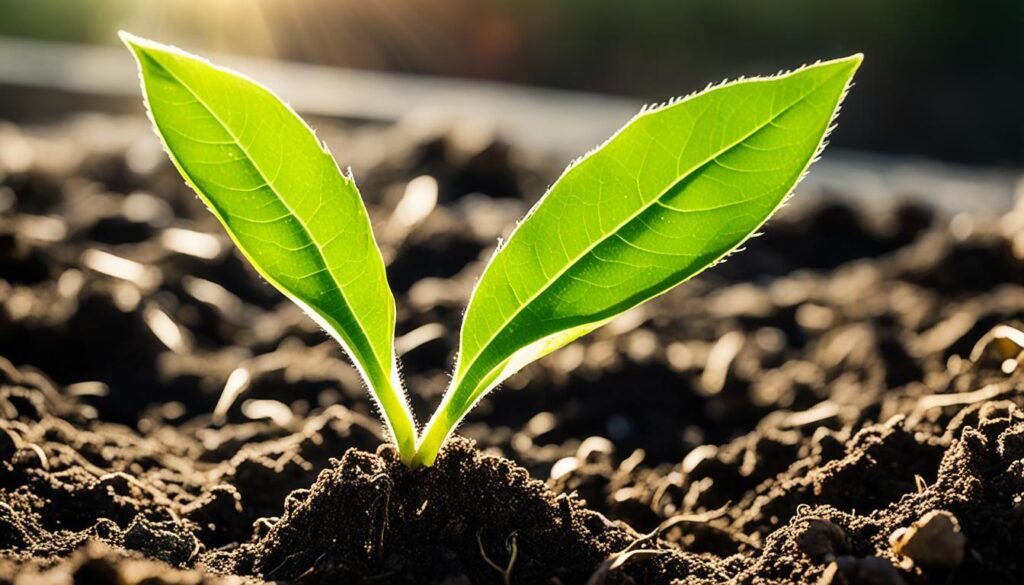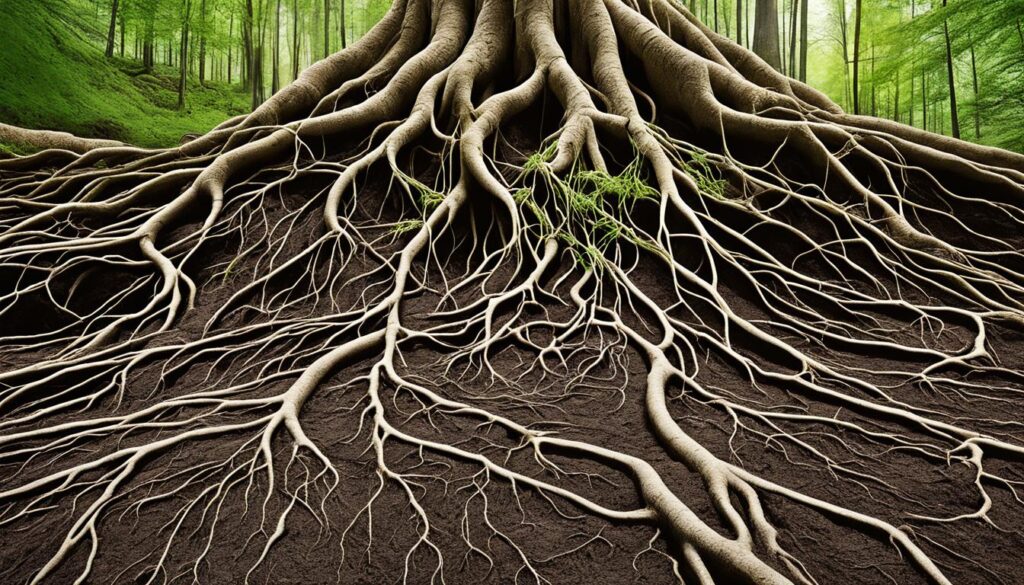Plant growth is a wonder of nature, powered by sunlight, water, and nutrients. At the core is photosynthesis, a process that interests scientists and nature lovers. By understanding photosynthesis, we learn how plants grow and their importance to our ecosystem.
From tall redwoods to colorful wildflowers, plants are vital to life on Earth. Knowing how they grow is both interesting and important for taking care of our planet. This article will dive into photosynthesis, showing what makes plants grow and the balance that keeps them alive.
The Miracle of Plant Growth
Plants have an amazing ability to grow and thrive. They take simple elements and turn them into complex, living beings. The process of plant growth is complex and involves many factors that help these life forms develop.
The plant life cycle is at the core of growth. It includes germination, growth, and reproduction. When a seed germinates, the plant starts a journey through different stages. Each stage builds on the last, turning the plant into a mature, thriving organism.
Many environmental factors affect plant growth. These include sunlight, water, nutrients, and carbon dioxide. Each factor is crucial for the plant’s growth and health.
The biology of plant growth is fascinating. As plants grow, their cells divide and get bigger. Specialized tissues and organs form, like roots, stems, leaves, and flowers. This shows how adaptable and resilient plants are.
From tall trees to small wildflowers, plant growth is a wonder. It shows the power and complexity of nature. By understanding this process, we appreciate the plant kingdom’s diversity and importance in supporting life on Earth.
What is Photosynthesis?
Photosynthesis is a key process in plant biology. It turns sunlight, carbon dioxide, and water into glucose. This glucose is the main energy source for plant growth and development. Understanding photosynthesis helps us appreciate how plants work.
The Photosynthesis Equation
The photosynthesis equation is simple yet powerful. It shows: 6CO2 + 6H2O → C6H12O6 + 6O2. Plants use sunlight to make glucose and oxygen from carbon dioxide and water.
Chloroplasts: The Powerhouses of Photosynthesis
Chloroplasts are the parts of plant cells where photosynthesis happens. They have chlorophyll and the tools needed for the chemical reactions. These reactions turn carbon dioxide and water into glucose. Chloroplasts are essential for plants to make energy from light.
Educational: Understanding the Photosynthesis Process
Photosynthesis is a key process in plant biology that captures the interest of scientists and gardeners. It’s a complex process where plants turn sunlight into the energy they need to grow. Knowing how photosynthesis works is key for those into plant science and learning.
At the core of photosynthesis are chloroplasts, tiny powerhouses inside plant cells. They have chlorophyll, the green stuff that makes plants green. When sunlight hits the chloroplasts, it starts a chain of reactions that makes glucose, the food plants need.
Photosynthesis has two main parts: the light-dependent and light-independent reactions, or the Calvin cycle. In the light-dependent stage, chloroplasts use sunlight to split water molecules. This releases electrons that make ATP and NADPH, the fuel for the next step.
In the light-independent stage, plants use ATP and NADPH to turn carbon dioxide into glucose. This process, called carbon fixation, is vital for plant growth. It lets plants make the carbs they need to grow strong.
Learning about photosynthesis helps students and plant lovers understand how plants use sunlight to live. This deep dive into photosynthesis is great for anyone wanting to know more about plant science and nature.
The Sun’s Role in Plant Growth
Sunlight is vital for plants. It gives them the energy they need for photosynthesis, which is key to their growth. By learning how plants use sunlight, we can understand nature better.
How Plants Capture Sunlight
Plants have special parts called chloroplasts that make photosynthesis happen. These have chlorophyll, a green stuff that turns sunlight into energy. Plants put these chloroplasts in the best spots to catch the sun’s rays.
Leaves start the process of catching sunlight. They have a thin, waxy layer to keep water in. Under this, they’re full of chloroplasts ready to soak up the sun’s rays. When sunlight hits, the chlorophyll in the chloroplasts gets excited, starting a chain that makes energy for the plant.

The sun is key to plant growth. Without sunlight, photosynthesis wouldn’t work. Plants use this energy to turn carbon dioxide and water into what they need to live. So, the sun is a vital part of life on Earth.
The Importance of Carbon Dioxide
Carbon dioxide (CO2) is key to photosynthesis, which is vital for plant growth. It’s the main gas plants turn into glucose and other compounds. This process fuels their growth and supports life on Earth.
Plants take in carbon dioxide during photosynthesis and change it into glucose with sunlight’s energy. This glucose gives them energy and helps build their tissues. Without enough carbon dioxide, photosynthesis stops, and plants won’t grow well.
Plants’ ability to take in carbon dioxide helps the environment too. As they grow, they remove carbon dioxide from the air. This helps fight climate change. The relationship between plants and the carbon cycle shows how life is connected and supports our planet.
Knowing how carbon dioxide affects plant biology is crucial for protecting our plants. Keeping a healthy balance of this gas helps plants grow and thrive. By understanding photosynthesis, we see how everything in nature is connected and depends on each other.
Water and Nutrient Uptake
Water and nutrients are key for plant growth and development. They are as important as sunlight and carbon dioxide for photosynthesis. The root system is vital for getting these elements to the plant’s parts, making photosynthesis work.
The Role of Roots in Plant Growth
Roots do more than just hold the plant in place. They are like the plant’s circulatory system underground. They have special cells and vessels to pull in water and nutrients from the soil. As the plant grows, roots spread out to get more of these important resources.
How well roots take in water and nutrients affects the plant’s health and growth. A strong root system sends these elements to the leaves, stems, and flowers. This helps the plant grow well and produce lots of growth. But weak roots can stop the plant from getting what it needs, causing it to grow poorly or not at all.

Knowing how roots help with water and nutrient uptake helps gardeners and horticulturists. They can improve their plants’ growing conditions. By preparing the soil well, watering and fertilizing right, and taking care of the roots, they can help plants reach their full potential.
Photosynthesis and Respiration: A Delicate Balance
At the core of a plant’s growth is the complex link between photosynthesis and respiration. These processes work together, creating a balance that keeps the plant alive.
Photosynthesis turns sunlight, carbon dioxide, and water into glucose and oxygen. This glucose is the plant’s main energy source, driving its growth. Respiration is the opposite, where the plant uses oxygen and gives off carbon dioxide. It changes the energy in glucose back into a form the plant can use.
The balance between photosynthesis and respiration is vital for a plant’s health and growth. In the day, with plenty of sunlight, photosynthesis wins, making more glucose than it uses. At night, respiration takes over, using stored glucose for the plant’s needs.
This balance lets plants get the energy they need to grow, develop leaves and roots, and survive. Knowing how photosynthesis and respiration work together helps us understand plant biology and growth.
The Byproducts of Photosynthesis
Photosynthesis is a key process that turns sunlight, carbon dioxide, and water into glucose for plants. It’s not just about growth and nourishment. This process also creates byproducts that greatly affect our world.
Oxygen: The Breath of Life
Oxygen is a crucial byproduct of photosynthesis. Plants take in carbon dioxide and release glucose, and they also let out oxygen. This oxygen goes into the air, which we and many other living things need to breathe.
This oxygen production is vital for our planet’s ecosystem. Without it, life as we know it would end. Oxygen is key for the breathing of animals, from big mammals to tiny microorganisms. It’s a must-have for life on Earth.
The effect of oxygen from photosynthesis on our environment is huge. With issues like climate change and air pollution, plants’ role in making oxygen is more crucial. Learning about this process helps us see how plants help our environment.
Exploring plant biology shows us how important photosynthesis and its byproducts, like oxygen, are. This knowledge helps us value nature more and work to keep our environment healthy.
The Impact of Photosynthesis on the Environment
Photosynthesis is key to our world. It’s the base of the global carbon cycle, affecting our ecosystems deeply. Plants turn carbon dioxide into oxygen and organic compounds. This helps keep the Earth’s climate stable and supports all life.
Photosynthesis fights climate change by taking in carbon dioxide and releasing oxygen. This reduces the amount of greenhouse gases in the air, slowing global warming. It shows how plants and the planet are connected and need each other to stay healthy.
Photosynthesis also makes oxygen, vital for most life on Earth. The oxygen plants produce is what we breathe, keeping our atmosphere balanced. This process connects all living things on our planet, showing the importance of photosynthesis.






